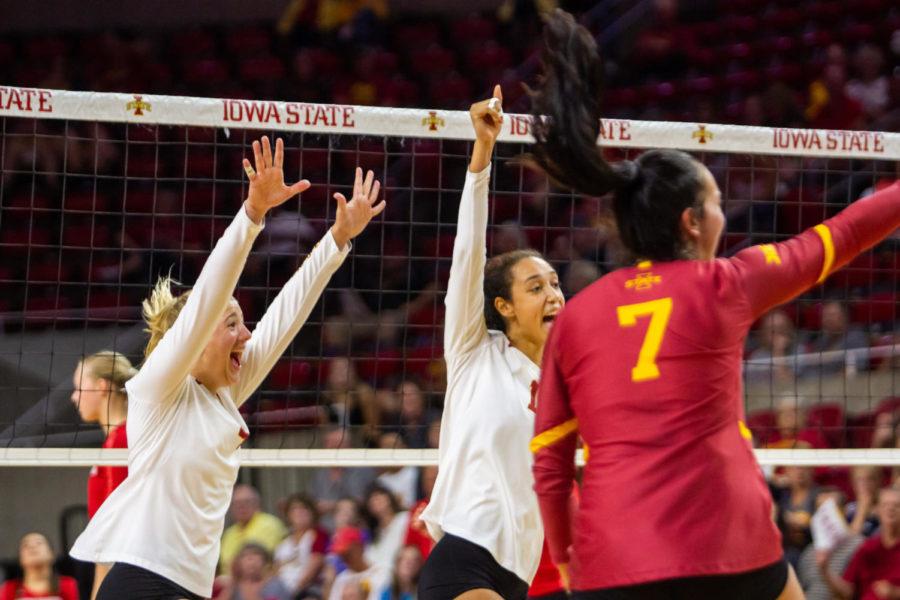Notebook: Iowa State volleyball gels on offense, needs work on block
September 17, 2019
Iowa State returned from the Appalachian Invitational with three more wins this past weekend, and after the early season shuffling with the lineup, the team is starting to click.
With all of the changes early on this season, from libero to more minor rotational changes, the Cyclones had yet to develop chemistry and the team’s younger players struggled to find their footing on the court, but at Appalachian State, the team began to click on the attack.
The team is finally developing chemistry
“I think Penn State, LSU was a low point for us and we weren’t gelling very well and it was a hard time for our team,” said libero/defensive specialist Izzy Enna.
Iowa State had an average hitting percentage of .125 against Penn State and LSU and the entire attack looked completely out of sync.
At libero, the team had just made the switch from Izzy Enna, last season’s incumbent, to freshman Jaiden Centeno.
“It was a really hard switch for me and I think for me it’s just knowing I’m still in there, still playing, so just staying positive at all times,” Enna said.
In the Cyclones’ system, the libero is usually the player with the most digs on the team and subsequently, the most first passes. The libero often initiates the beginning of the attack and an errant pass to setter Piper Mauck can result in a wasted hitting opportunity.
Early in the season, coach Johnson-Lynch said the team needed to improve their ball control and passing, and at the Appalachian Invitational, the Cyclones, specifically in the back row, began to gel and passing began to improve.
Iowa State’s players are beginning to settle into their new roles — including Enna, who has challenged herself to maintain a libero’s stats even though she is primarily playing defensive specialist. So far, she has been doing just that, and after the Penn State game, she has been averaging 14.2 digs a game.
Improved passing leads to a comeback offensive performance
With more on-court chemistry, Iowa State’s back row had really good passing numbers at Appalachian State, according to Johnson-Lynch, and the team’s offensive numbers blossomed as a result.
When receiving the ball of an attack or serve, Johnson-Lynch said the quality of the first pass from the Cyclones is a result of technique, repetition and confidence as well as the players’ chemistry.
“Some of it’s who you are passing next to and working out who takes what ball,” Johnson-Lynch said. “You know that ball’s coming so quickly and you have milliseconds to figure out who’s taking it.”
The space between two passing players is called the seam and being able to decide which player will take on the ball in that area is vital to a quality pass.
Early in the season, Iowa State’s lack of communication and rapport between players in the seam was evident as players would make tough plays on balls, resulting in a shanked pass, while the other player would have had no problem handling the ball or even running into each other in a couple instances.
This past weekend, those problems weren’t there.
“We had some of the best passing we’ve had in a while this season and then a lot of that was just our hitters getting up and transition and feeling comfortable with what they’re hitting,” Mauck said.
Block still needs to come together
“I think our offense started to click, now our block and defense has to kind of come along with it,” Johnson-Lynch said.
Johnson-Lynch said Iowa State is an ‘OK’ blocking team, but the team could be leagues better from where they are now.
Iowa State is averaging 2.1 blocks per set while the NCAA leader in that category, Utah, averaged 3.36.
Moving forward, improvement should come in strides with two solid players, Avery Rhodes and Candelaria Herrera, at middle blocker.
Rhodes — who is coming off of a hip surgery from last season — has already registered a ten-block game, while Herrera started at middle blocker for the Argentinian national team — a top 15 team in the world — and Johnson-Lynch said Herrera could be one of the best blockers in the nation this season.
Johnson-Lynch said the team’s largest struggle thus far is being able to take on outside hitters at the outside pins of the court, which comes with better anticipation by reading the ball off of the hands of the setter and watching the approach of the hitters.
“Blocking is simple in that it’s about getting your hands across the net when the hitter’s hitting, but so much of it’s timing and that timing needs to be just about perfect to block the ball or funnel it to the defender,” Johnson-Lynch said.







